Statistical Modelling for the Source Rock Parameters of the Montney Formation, NE British Columbia, Canada
Abstract
:1. Introduction
2. Overview of Montney Formation
3. Geological Setting
4. Materials and Methods
4.1. Sample Collection
4.2. Methodology
4.2.1. Geochemical Analysis
4.2.2. Statistical Analyses
Spearman Correlation Coefficient (ρ)
Principal Component Analysis
Cluster Analysis
5. Results and Discussion
5.1. TOC Quantity and Quality of Organic Matter
5.2. Kerogen Type and Generating Potential
5.3. Organic Matter Maturity
5.4. Statistical Analysis Results
5.4.1. Spearman Correlation Coefficient (ρ)
5.4.2. Principal Component Analysis (PCA)
5.4.3. Cluster Analysis
6. Conclusions
- The TOC for the source rock presented in this study ranged from 0.5 to 2.86 wt.%, which was interpreted as fair to good source rock.
- The hydrocarbon linked with the Montney Formation in the examined samples ranged from oil to dry gas with a medium to a high level of conversion depending on the Tmax and PI, originating from Type IV kerogen.
- The higher values of the S1 compared with the S2 are likely to be interpreted as stained or contaminated source rock.
- The Spearman’s correlation coefficient showed that the TOC had positive correlations with each of S1, S2, and GP, indicating that S1 and S2 contributed to TOC; additionally, the positive correlation with HI and negative correlation with OI, along with weak correlations with both Tmax and PI, indicated that the maturity of the source rocks was independent of the amount of organic matter.
- The PCA application categorized the pyrolysis parameters into three factors that influenced the source rock evaluation. TOC, S1, S2, and OI were all part of Factor 1, which determines the richness and potentiality. Factor 2 consisted of PI and S3, which reflected the maturity of the source rock. Tmax and HI of Factor 3 indicated the kerogen’s maturity level, source, and type.
- The clustering methods used in this study showed the efficiency and reliability of the TwoStep algorithm in contrast to the HCA algorithm.
- Using the TwoStep clustering method showed that there were two clusters within the Montney Formation. The first lay in the oil window zone with relatively high TOC, S1, S2, S3, HI, PI, and GP, accompanied by low Tmax and neutral OI (Figure 8). The second cluster was in the dry gas window with relatively low TOC, S1, S2, S3, HI, PI, and GP, accompanied by high Tmax and neutral OI.
- Statistical modelling demonstrates that it is a valuable tool for uncovering previously unknown relationships between variables.
7. Recommendations, Applications and Future Work
Author Contributions
Funding
Institutional Review Board Statement
Informed Consent Statement
Data Availability Statement
Acknowledgments
Conflicts of Interest
References
- BC Oil & Gas Commission. British Columbia’s Oil and Gas Reserves and Production Report; BC Oil & Gas Commission: West Paris, ME, USA, 2015; Available online: http://www.bcogc.ca/node/13607/download (accessed on 5 October 2017).
- Walsh, W.; Adams, C.; Kerr, B.; Korol, J. Regional “Shale Gas” Potential of the Triassic Doig and Montney Formations, Northeastern British Columbia; British Columbia Ministry of Energy, Mines and Petroleum Resources, Resource Development and Geoscience Branch: Vancouver, BC, Canada, 2006; p. 2006-02.
- Adams, C.; Janicki, E.; Balogun, A. Summary of Shale Gas Activity in Northeast British Columbia 2011; BC Ministry of Natural Gas Development: Vancouver, BC, Canada, 2013; pp. 1–27.
- Haines, L.; Darbonne, N.; Barbee, M.A.; Williams, P.; Clouser, G.; Wagman, D.; Conly, M.; Grant, J. Tight Gas; Hart Energy Publishing: Houston, TX, USA, 2006; 14p. [Google Scholar]
- Schmoker, J.W. Method for Assessing Continuous-Type (Unconventional) Hydrocarbon Accumulations; Gautier, D.L., Dolton, G.L., Takahashi, K.I., Varnes, K.L., Eds.; National Assessment of United States Oil and Gas Resources—Results, Methodology, and Supporting Data: U.S. Geological Survey Digital Data Series, 30, CD-ROM; U.S. Geological Survey: Reston, VA, USA, 1995.
- Tissot, B.P.; Welte, D.H. Petroleum Formation and Occurrence; Springer Science & Business Media: Berlin/Heidelberg, Germany, 2013. [Google Scholar]
- Hunt, J.M. Petroleum Geochemistry and Geology; W.H. Freeman and Company: New York, NY, USA, 1995. [Google Scholar]
- Lecompte, B.; Hursan, G. Quantifying Source Rock Maturity from Logs: How to Get More than TOC from Delta Log R. In SPE Annual Technical Conference and Exhibition; Society of Petroleum Engineers: Richardson, TX, USA, 2010. [Google Scholar]
- Dembicki, H. Practical Petroleum Geochemistry for Exploration and Production; Elsevier: Amsterdam, The Netherlands, 2016. [Google Scholar]
- Peters, K.E.; Fowler, M.G. Applications of petroleum geochemistry to exploration and reservoir management. Org. Geochem. 2002, 33, 5–36. [Google Scholar] [CrossRef]
- El Nady, M.M.; Ramadan, F.S.; Hammad, M.M.; Lotfy, N.M. Evaluation of organic matters, hydrocarbon potential and thermal maturity of source rocks based on geochemical and statistical methods: Case study of source rocks in Ras Gharib oilfield, central Gulf of Suez, Egypt. Egypt. J. Pet. 2015, 24, 203–211. [Google Scholar] [CrossRef] [Green Version]
- Millayanti, A.; Aprianto, A.R.; Fauzan, R.F.; Anggara, M.U. Evaluation of Organic Matters, Hydrocarbon Potential and Thermal Maturity of Source Rocks Based on Geochemical and Statistical Methods: Case Study Miocene of the Seblat and Lemau Formation, Bengkulu Basin. IOP Conf. Ser. Earth Environ. Sci. 2019, 248, 012075. [Google Scholar] [CrossRef] [Green Version]
- Edwards, D.S.; Struckmeyer, H.I.M.; Bradshaw, M.T.; Skinner, J.E. Geochemical characteristics of Australia’s southern margin petroleum systems. APPEA J. 1999, 39, 297–321. [Google Scholar] [CrossRef]
- BC Oil & Gas Commission (BCOGC). Industry Bulletin 2011-33, Submission Information for Disclosure of Hydraulic Fracturing Fluids, British Columbia, Canada; BCOGC: Fort St. John, BC, Canada, 2011. [Google Scholar]
- Edwards, D.; Barclay, J.; Gibson, D.W.; Kvill, G.E.; Halton, E. Triassic strata of the Western Canada sedimentary basin. Bull. Can. Pet. Geol. 1990, 38, 163. [Google Scholar]
- Orchard, M.; Zonneveld, J.-P. The Lower Triassic Sulphur Mountain Formation in the Wapiti Lake area: Lithostratigraphy, conodont biostratigraphy, and a new biozonation for the lower Olenekian (Smithian) Earth Science Sector (ESS) Contribution 20080714. Can. J. Earth Sci. 2009, 46, 757–790. [Google Scholar] [CrossRef]
- Podruski, J.; Barclay, J.; Lee, P.J.; Osadetz, K.G.; Hamblin, A.P.; Procter, R.G.; Taylor, G.C. Conventional Oil Resources of Western Canada (Light and Medium); Geological Survey of Canada, Paper 87–26; Geological Survey of Canada: Ottawa, ON, Canada, 1988; pp. 1–125.
- Riediger, C.L.; Brooks, P.W.; Fowler, M.G.; Snowdon, L.R. Lower and Middle Triassic source rocks, thermal maturation, and oil-source rock correlations in the Peace River Embayment area, Alberta and British Columbia. Bull. Can. Pet. Geol. 1990, 38, 218–235. [Google Scholar]
- Gibson, D.; Edwards, D. An overview of Triassic stratigraphy and depositional environments in the Rocky Mountain foothills and western interior plains, Peace River arch area, northeastern British Columbia. Bull. Can. Pet. Geol. 1990, 38, 146–158. [Google Scholar]
- Barclay, J.E.; Krause, F.F.; Campbell, R.I.; Utting, J. Dynamic casting and growth faulting: Dawson Creek graben complex, Carboniferous-Permian Peace River embayment, western Canada. Bull. Can. Pet. Geol. 1990, 38, 115–145. [Google Scholar]
- Davies, G.R.; Moslow, T.F.; Sherwin, M.D. The lower Triassic Montney formation, west-central Alberta. Bull. Can. Pet. Geol. 1997, 45, 474–505. [Google Scholar]
- Orchard, M.; Tozer, E. Triassic conodont biochronology, its calibration with the ammonoid standard, and a biostratigraphic summary for the Western Canada Sedimentary Basin. Bull. Can. Pet. Geol. 1997, 45, 675–692. [Google Scholar]
- Zonneveld, J.-P. Sedimentology and Sequence Biostratigraphic Framework of a Mixed Siliciclastic-Carbonate Depositional System, Middle Triassic, Northeastern British Columbia. Ph.D. Thesis, University of Alberta, Edmonton, AB, Canada, 1999. [Google Scholar]
- Zonneveld, J.-P.; Gingras, M.; Pemberton, S. Trace fossil assemblages in a Middle Triassic mixed siliciclastic-carbonate marginal marine depositional system, British Columbia. Palaeogeogr. Palaeoclim. Palaeoecol. 2001, 166, 249–276. [Google Scholar] [CrossRef]
- Willis, A.J.; Moslow, T.F. Sedimentology and stratigraphy of tidal inlet reservoirs in the Triassic Halfway Formation, Wembley Field, Alberta. Bull. Can. Pet. Geol. 1994, 42, 245–262. [Google Scholar]
- Davies, G.R. The Triassic of the Western Canada Sedimentary Basin: Tectonic and stratigraphic framework, paleogeography, paleoclimate and biota. Bull. Can. Pet. Geol. 1997, 45, 434–460. [Google Scholar]
- Sellwood, B.W.; Valdes, P.J. Mesozoic climates: General circulation models and the rock record. Sediment. Geol. 2006, 190, 269–287. [Google Scholar] [CrossRef]
- Playter, T.L. Petrographic and X-ray Microtomographic Analysis of the Upper Montney Formation, Northeastern British Columbia, Canada; University of Alberta (Canada): Edmonton, AB, Canada, 2013. [Google Scholar]
- Raup, D.M. Size of the Permo-Triassic Bottleneck and Its Evolutionary Implications. Science 1979, 206, 217–218. [Google Scholar] [CrossRef] [PubMed]
- Erwin, D.H. Extinction: How Life on Earth Nearly Ended 250 Million Years Ago; Princeton University Press: Princeton, NJ, USA, 2006. [Google Scholar]
- Zonneveld, J.-P.; Beatty, T.W.; Macnaughton, R.B.; Pemberton, S.G.; Utting, J.; Henderson, C.M. Sedimentology and ichnology of the Lower Triassic Montney Formation in the Pedigree-Ring/Border-Kahntah River area, northwestern Alberta and northeastern British Columbia. Bull. Can. Pet. Geol. 2010, 58, 115–140. [Google Scholar] [CrossRef]
- Woods, A.D.; Bottjer, D.J.; Corsetti, F.A. Calcium carbonate seafloor precipitates from the outer shelf to slope facies of the Lower Triassic (Smithian-Spathian) Union Wash Formation, California, USA: Sedimentology and palaeobiologic significance. Palaeogeogr. Palaeoclim. Palaeoecol. 2007, 252, 281–290. [Google Scholar] [CrossRef]
- Zonneveld, J.-P.; Gingras, M.K.; Beatty, T.W. Diverse ichnofossil assemblages following the p-t mass extinction, lower triassic, alberta and british columbia, canada: Evidence for shallow marine refugia on the northwestern coast of pangaea. Palaios 2010, 25, 368–392. [Google Scholar] [CrossRef]
- Moslow, T.F.; Davies, G.R. Turbidite reservoir facies in the Lower Triassic Montney Formation, west-central Alberta. Bull. Can. Pet. Geol. 1997, 45, 507–536. [Google Scholar]
- Moslow, T.F. Reservoir architecture of a fine-grained turbidite system: Lower Triassic Montney Formation, Western Canada Sedimentary Basin. In Deep-Water Reservoirs of the World; Weimer, P., Slatt, R.M., Coleman, J., Rosen, N.C., Nelson, H., Bouma, A.H., Styzen, M.J., Lawrence, D.T., Eds.; Gulf Coast SEPM: Houston, TX, USA, 2000. [Google Scholar]
- Utting, J.; Zonneveld, J.; Macnaughton, R.; Fallas, K. Palynostratigraphy, lithostratigraphy and thermal maturity of the Lower Triassic Toad and Grayling, and Montney formations of western Canada, and comparisons with coeval rocks of the Sverdrup Basin, Nunavut. Bull. Can. Pet. Geol. 2005, 53, 5–24. [Google Scholar] [CrossRef]
- Zonneveld, J.-P.; Moslow, T.F. Palaeogeographic setting, lithostratigraphy, and sedimentary framework of the Lower Triassic Montney Formation of western Alberta and northeastern British Columbia. Bull. Can. Pet. Geol. 2018, 66, 93–127. [Google Scholar]
- Espitalie, J.; Laporte, J.; Madec, M.; Marquis, F.; Leplat, P.; Paulet, J.; Boutefeu, A. Méthode rapide de caractérisation des roches mètres, de leur potentiel pétrolier et de leur degré d’évolution. Rev. Inst. Franc. Pétrole 1977, 32, 23–42. [Google Scholar] [CrossRef]
- Behar, F.; Beaumont, V.; Penteado, H.L.D.B. Rock-Eval 6 Technology: Performances and Developments. Oil Gas Sci. Technol. Rev. IFP 2001, 56, 111–134. [Google Scholar] [CrossRef]
- Barker, C. Pyrolysis techniques for source-rock evaluation. AAPG Bull. 1974, 58, 2349–2361. [Google Scholar]
- Peters, K.E. Guidelines for Evaluating Petroleum Source Rock Using Programmed Pyrolysis. AAPG Bull. 1986, 70, 318–329. [Google Scholar]
- Peters, K.E.; Cassa, M.R. Applied Source Rock Geochemistry: Chapter 5: Part II. Essential Elements; Datapages Inc.: Tulsa, UK, USA, 1994; pp. 93–120. [Google Scholar]
- Al-Areeq, N.M.; Al-Badani, M.A.; Salman, A.H.; Albaroot, M.A. Petroleum source rocks characterization and hydrocarbon generation of the Upper Jurassic succession in Jabal Ayban field, Sabatayn Basin, Yemen. Egypt. J. Pet. 2018, 27, 835–851. [Google Scholar] [CrossRef]
- Landau, S. A Handbook of Statistical Analyses Using SPSS; CRC: Boca Raton, FL, USA, 2004. [Google Scholar]
- Jolliffe, I.T.; Cadima, J. Principal component analysis: A review and recent developments. Philos. Trans. R. Soc. A Math. Phys. Eng. Sci. 2016, 374, 20150202. [Google Scholar] [CrossRef]
- Rokach, L.; Maimon, O. Clustering Methods. In Data Mining and Knowledge Discovery Handbook; Springer: Berlin/Heidelberg, Germany, 2005; pp. 321–352. [Google Scholar]
- Garson, D. Correspondence Analysis, from Statnotes: Topics in Multivariate Analysis. 2008. Available online: http://faculty.chass.ncsu.edu/garson/pa765 (accessed on 2 August 2011).
- Şchiopu, D. Applying TwoStep cluster analysis for identifying bank customers’ profile. Buletinul 2010, 62, 66–75. [Google Scholar]
- Zhang, T.; Ramakrishnan, R.; Livny, M. BIRCH: An efficient data clustering method for very large databases. ACM Sigmod Rec. 1996, 25, 103–114. [Google Scholar] [CrossRef]
- Tissot, B.; Welte, D. Petroleum Formation and Occurrence, 2nd ed.; Springer: Berlin/Heidelberg, Germany, 1984; 699p. [Google Scholar]
- Langford, F.; Blanc-Valleron, M.-M. Interpreting Rock-Eval pyrolysis data using graphs of pyrolizable hydrocarbons vs. total organic carbon. AAPG Bull. 1990, 74, 799–804. [Google Scholar]
- Espitalie, J.; Deroo, G.; Marquis, F. Rock-Eval pyrolysis and its applications. Rev. Inst. Franc. Pétrole 1985, 40, 563–579. [Google Scholar]

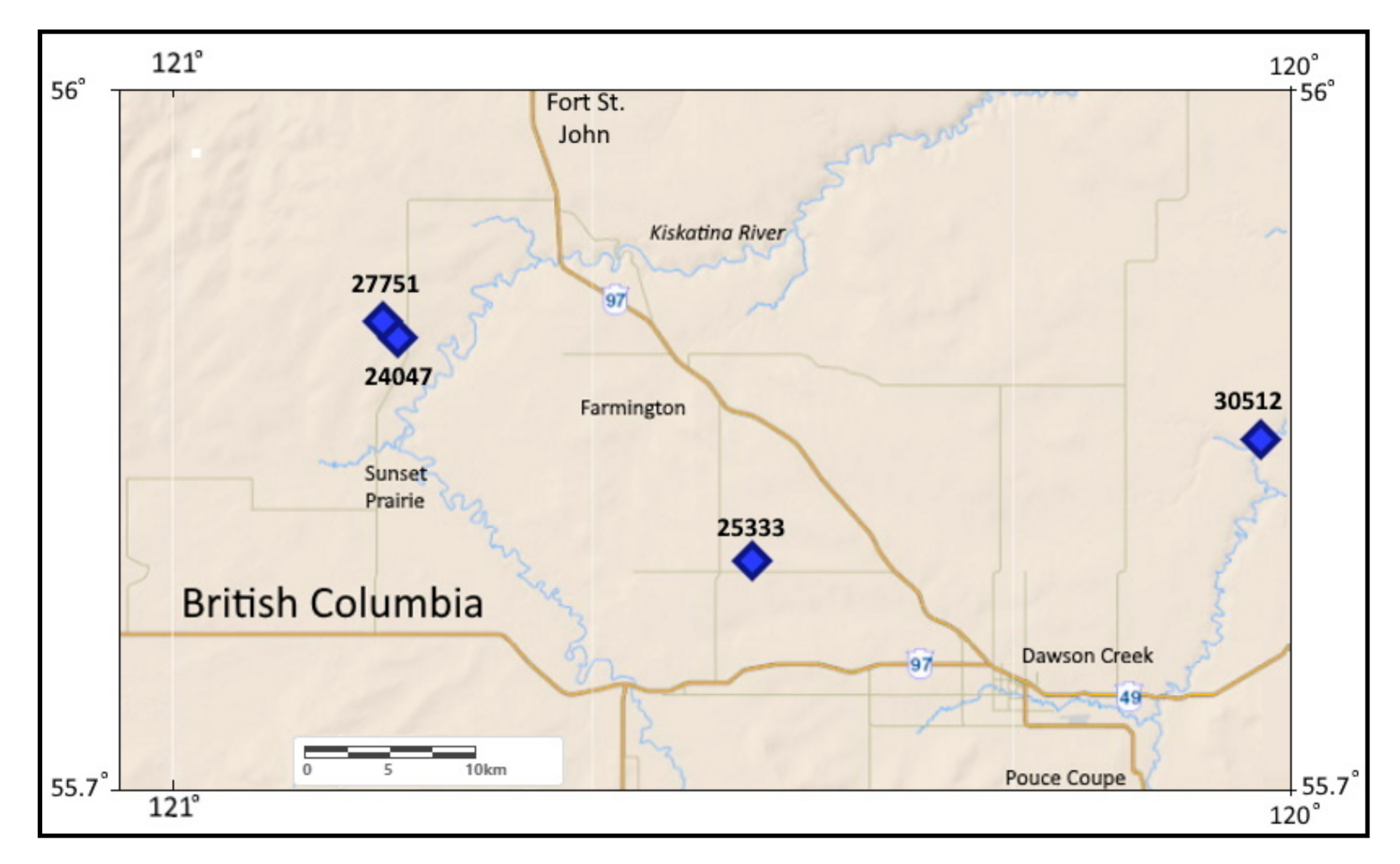
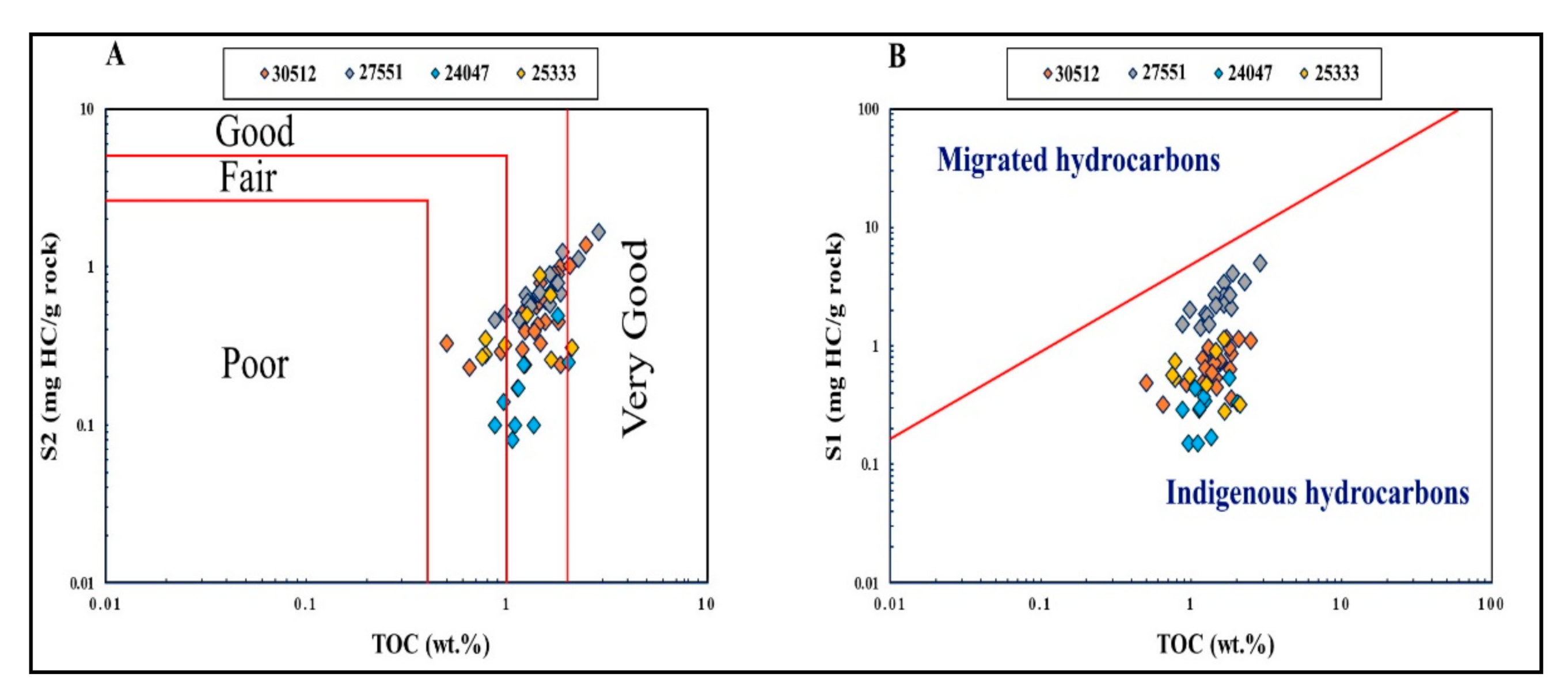
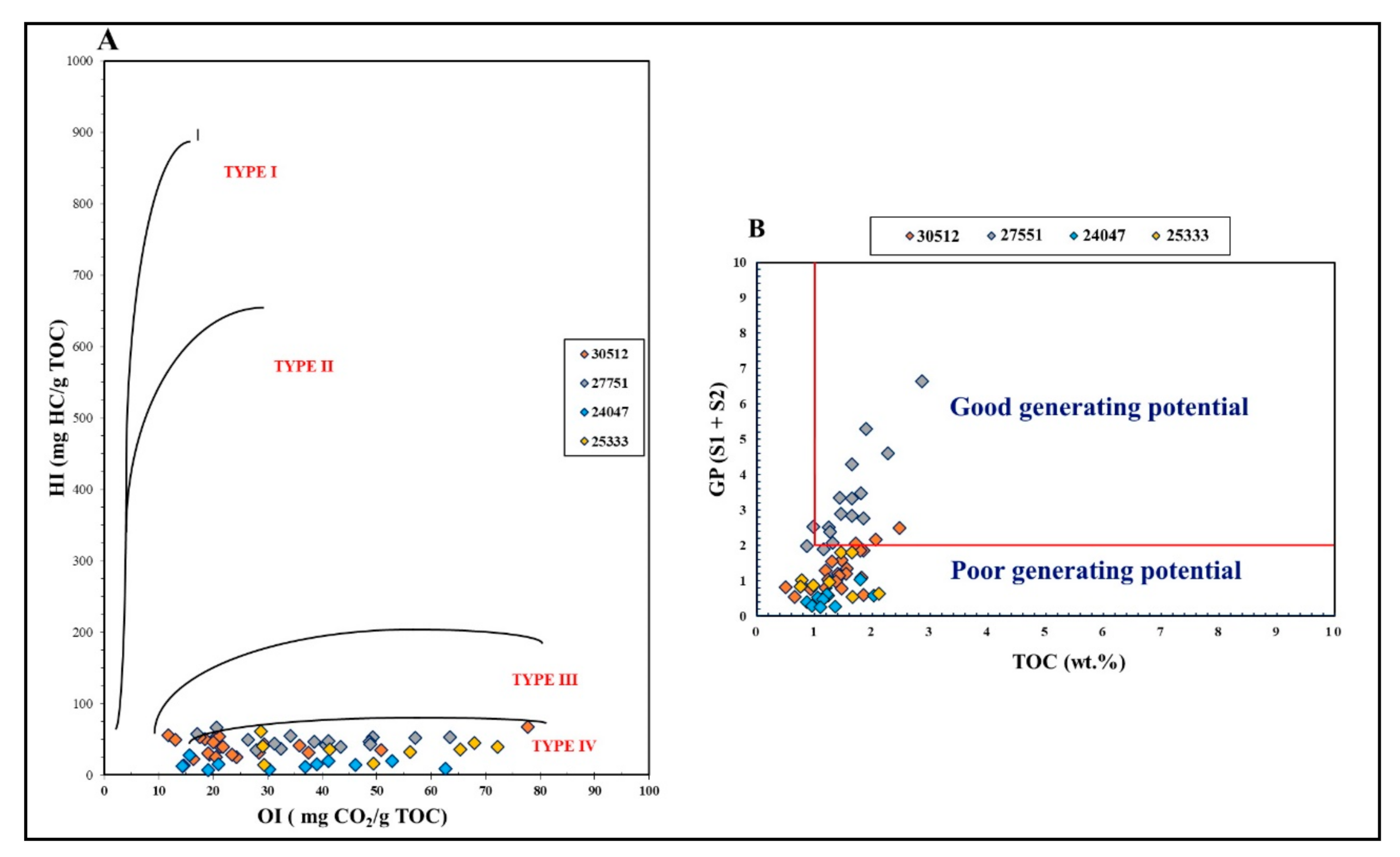
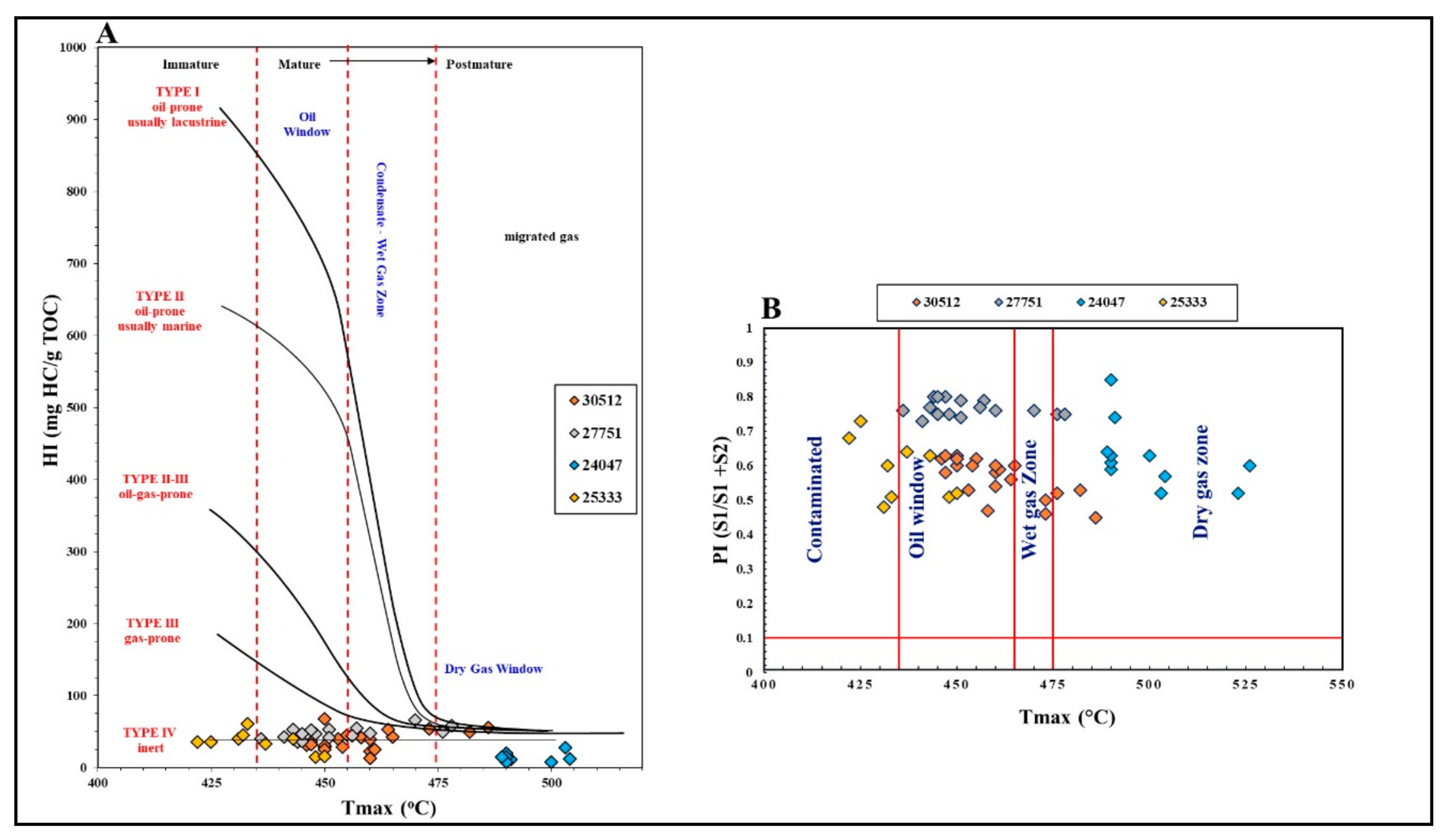

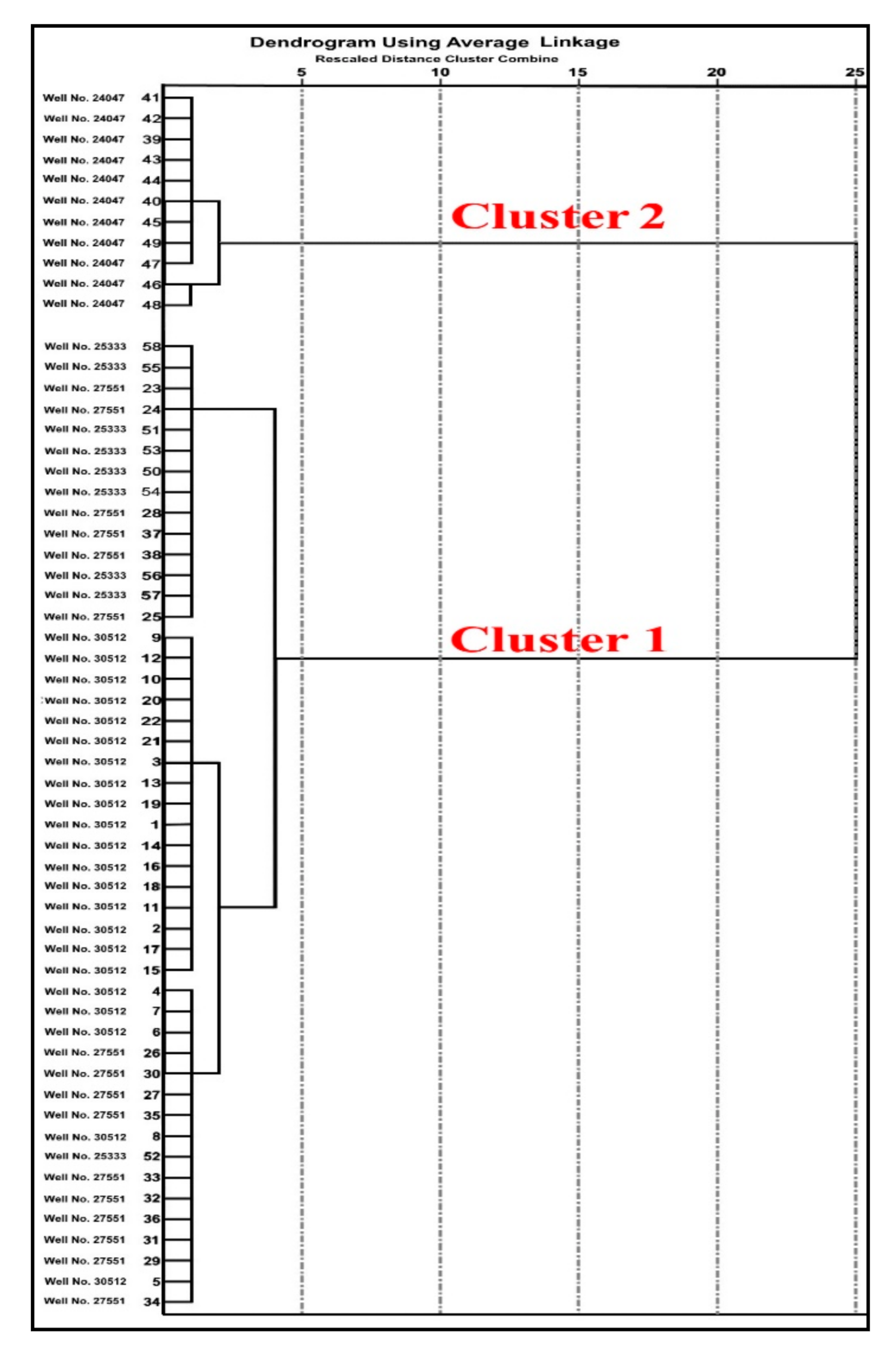
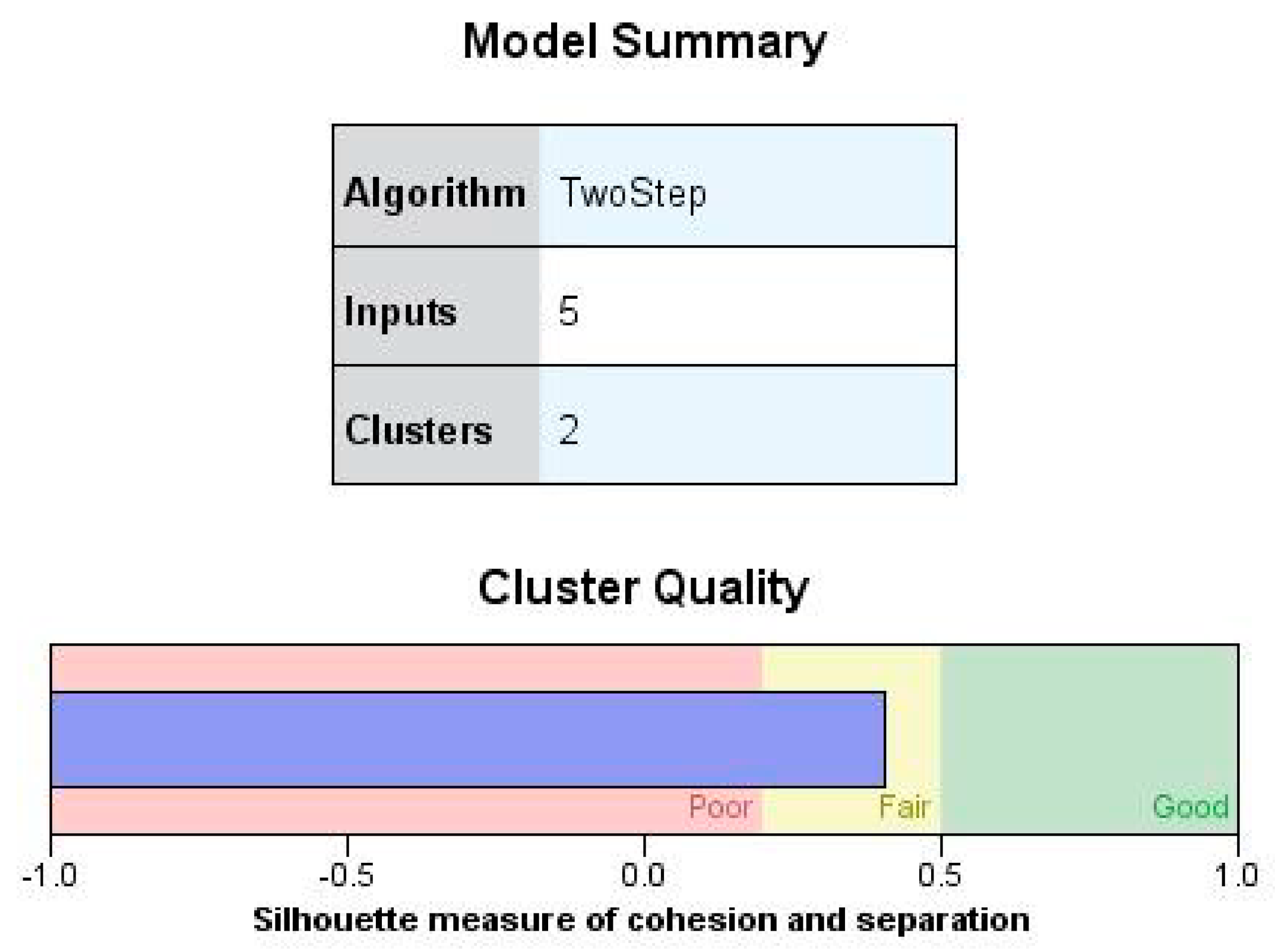
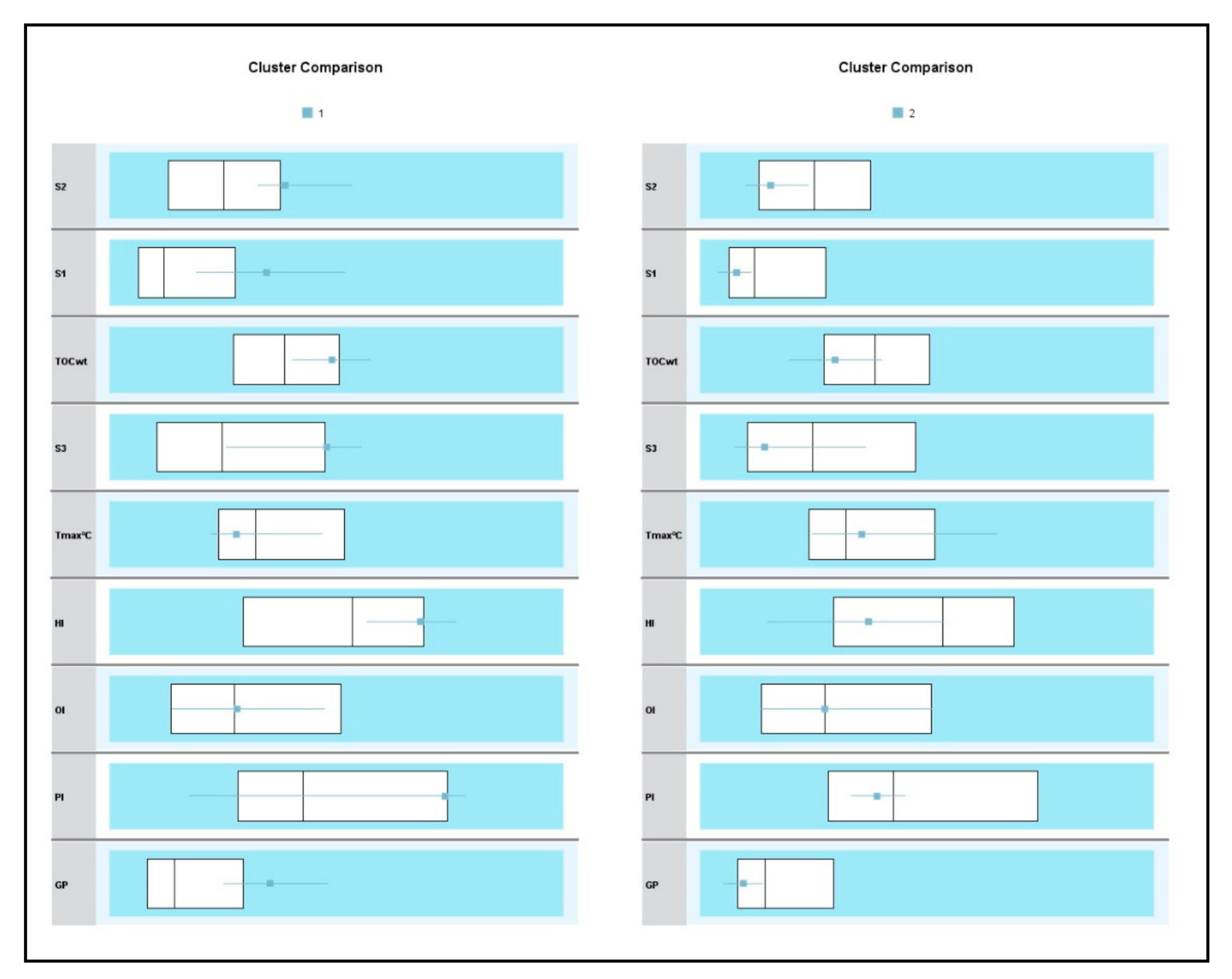
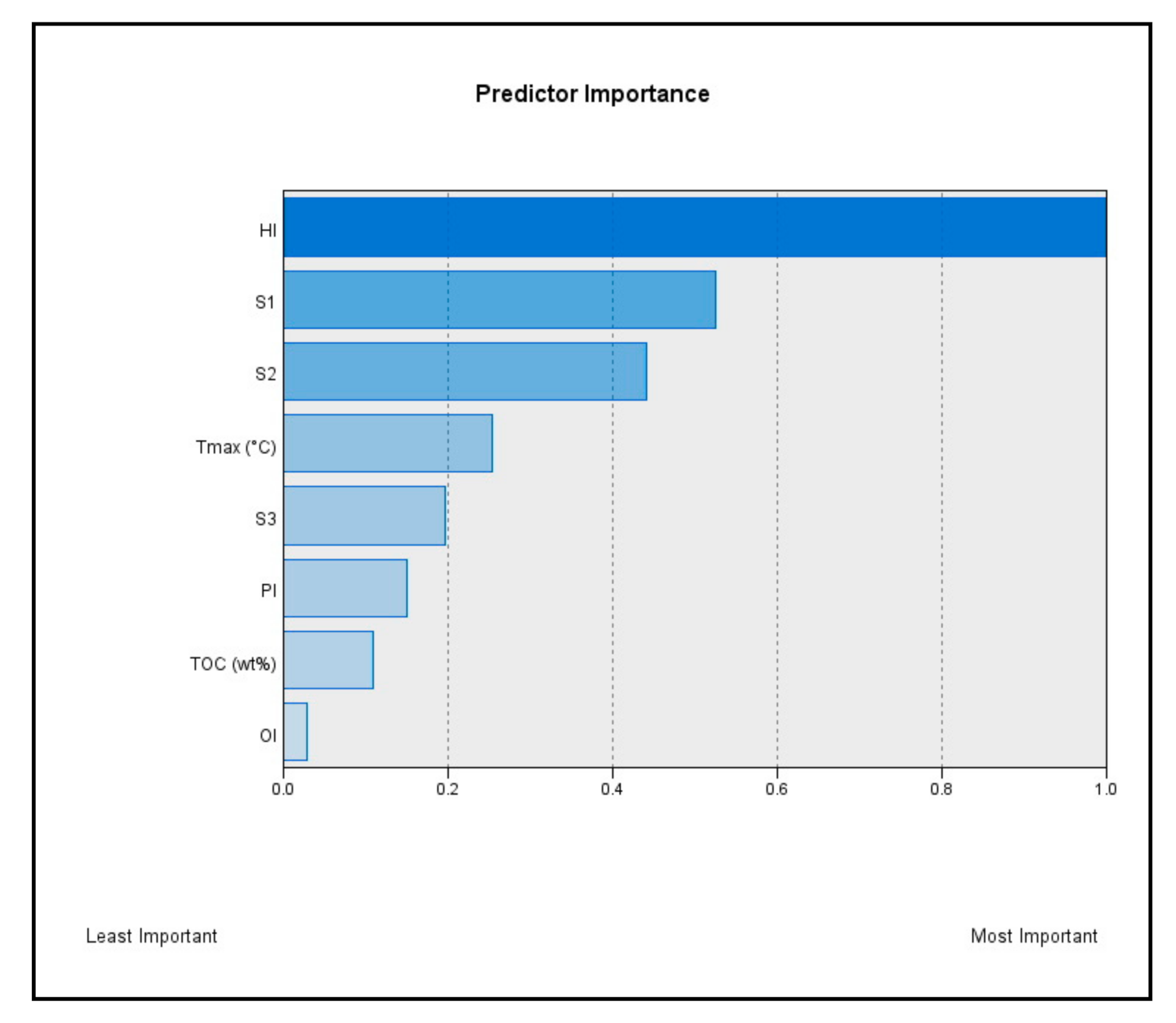
| Well Location | Well, No. | Depth (m) | TOC (wt.%) | S1 mg HC/g rock | S2 mg HC/g rock | S3 mg CO2/g rock | Tmax (°C) | HI mg HC/g TOC | OI mg CO2/ g TOC | PI | GP (S1 + S2) |
|---|---|---|---|---|---|---|---|---|---|---|---|
| A01-17-080-18 | 30512 | 2386.05 | 1.4 | 0.63 | 0.56 | 0.3 | 453 | 39.91 | 21.38 | 0.53 | 1.19 |
| 2396.05 | 0.65 | 0.32 | 0.23 | 0.33 | 447 | 35.38 | 50.77 | 0.58 | 0.55 | ||
| 2406.28 | 1.45 | 0.54 | 0.6 | 0.52 | 458 | 41.41 | 35.89 | 0.47 | 1.14 | ||
| 2416.44 | 1.84 | 0.86 | 0.99 | 0.38 | 473 | 53.78 | 20.64 | 0.46 | 1.85 | ||
| 2426.55 | 2.47 | 1.11 | 1.38 | 0.29 | 486 | 55.85 | 11.74 | 0.45 | 2.49 | ||
| 2436.75 | 1.79 | 0.96 | 0.9 | 0.33 | 476 | 50.36 | 18.47 | 0.52 | 1.86 | ||
| 2446.92 | 1.47 | 0.8 | 0.79 | 0.31 | 473 | 53.85 | 21.13 | 0.5 | 1.59 | ||
| 2456.19 | 2.06 | 1.14 | 1.02 | 0.27 | 482 | 49.44 | 13.09 | 0.53 | 2.16 | ||
| 2466.25 | 1.19 | 0.78 | 0.51 | 0.35 | 465 | 42.79 | 29.36 | 0.6 | 1.29 | ||
| 2476.55 | 1.56 | 0.73 | 0.61 | 0.34 | 460 | 39.15 | 21.82 | 0.54 | 1.34 | ||
| 2486.85 | 0.5 | 0.49 | 0.33 | 0.38 | 450 | 67.48 | 77.71 | 0.6 | 0.82 | ||
| 2496.9 | 1.71 | 1.16 | 0.9 | 0.3 | 464 | 52.79 | 17.6 | 0.56 | 2.06 | ||
| 2506.1 | 1.3 | 0.96 | 0.59 | 0.26 | 455 | 45.45 | 20.03 | 0.62 | 1.55 | ||
| 2516.35 | 1.55 | 0.75 | 0.45 | 0.3 | 450 | 28.99 | 19.33 | 0.63 | 1.2 | ||
| 2526.61 | 0.93 | 0.48 | 0.29 | 0.35 | 446 | 31.12 | 37.55 | 0.62 | 0.77 | ||
| 2536.2 | 1.42 | 0.71 | 0.43 | 0.27 | 450 | 30.3 | 19.03 | 0.62 | 1.14 | ||
| 2546.71 | 1.23 | 0.65 | 0.39 | 0.35 | 447 | 31.71 | 28.46 | 0.63 | 1.04 | ||
| 2556.62 | 1.19 | 0.49 | 0.3 | 0.29 | 450 | 25.13 | 24.29 | 0.62 | 0.79 | ||
| 2566.2 | 1.37 | 0.59 | 0.39 | 0.32 | 454 | 28.51 | 23.39 | 0.6 | 0.98 | ||
| 2576.15 | 1.47 | 0.45 | 0.33 | 0.24 | 460 | 22.43 | 16.32 | 0.58 | 0.78 | ||
| 2586.34 | 1.81 | 0.64 | 0.45 | 0.37 | 461 | 24.9 | 20.48 | 0.59 | 1.09 | ||
| 2592.35 | 1.85 | 0.36 | 0.24 | 0.27 | 460 | 13.01 | 14.63 | 0.6 | 0.6 | ||
| B-093-I/094-B-09 | 27751 | 1851.08 | 2.27 | 3.48 | 1.13 | 0.6 | 476 | 49.8 | 26.44 | 0.75 | 4.61 |
| 1860.1 | 2.86 | 4.98 | 1.66 | 0.49 | 478 | 57.96 | 17.11 | 0.75 | 6.64 | ||
| 1869.09 | 1.89 | 4.05 | 1.25 | 0.39 | 470 | 66.17 | 20.65 | 0.76 | 5.3 | ||
| 1878.34 | 1.24 | 1.85 | 0.66 | 0.61 | 451 | 53.31 | 49.27 | 0.74 | 2.51 | ||
| 1889.01 | 1.27 | 1.79 | 0.6 | 0.62 | 448 | 47.17 | 48.74 | 0.75 | 2.39 | ||
| 1898.08 | 1.64 | 3.39 | 0.9 | 0.56 | 457 | 54.84 | 34.13 | 0.79 | 4.29 | ||
| 1908.06 | 0.87 | 1.52 | 0.46 | 0.55 | 443 | 53.06 | 63.44 | 0.77 | 1.98 | ||
| 1918.13 | 1.65 | 2.64 | 0.69 | 0.67 | 451 | 41.84 | 40.63 | 0.79 | 3.33 | ||
| 1933.04 | 1.64 | 2.25 | 0.58 | 0.46 | 444 | 35.28 | 27.98 | 0.8 | 2.83 | ||
| 1943.11 | 1.85 | 2.08 | 0.68 | 0.6 | 445 | 36.68 | 32.36 | 0.75 | 2.76 | ||
| 1953.11 | 1.15 | 1.43 | 0.46 | 0.5 | 436 | 39.93 | 43.4 | 0.76 | 1.89 | ||
| 1963 | 1.31 | 1.52 | 0.56 | 0.64 | 441 | 42.68 | 48.78 | 0.73 | 2.08 | ||
| 1973.1 | 0.98 | 2.01 | 0.51 | 0.56 | 447 | 51.93 | 57.03 | 0.8 | 2.52 | ||
| 1983.1 | 1.43 | 2.68 | 0.67 | 0.55 | 445 | 47.02 | 38.6 | 0.8 | 3.35 | ||
| 1998.18 | 1.8 | 2.69 | 0.79 | 0.56 | 456 | 44.01 | 31.2 | 0.77 | 3.48 | ||
| 2003.08 | 1.46 | 2.2 | 0.69 | 0.6 | 460 | 47.39 | 41.21 | 0.76 | 2.89 | ||
| b-65-J/94-B-16 | 24047 | 2023 | 1.23 | 0.34 | 0.24 | 0.65 | 490 | 19.53 | 52.89 | 0.59 | 0.58 |
| 2029.8 | 0.87 | 0.29 | 0.1 | 0.32 | 491 | 11.55 | 36.95 | 0.74 | 0.39 | ||
| 2035.3 | 1.21 | 0.37 | 0.24 | 0.5 | 490 | 19.77 | 41.19 | 0.61 | 0.61 | ||
| 2039.3 | 1.13 | 0.29 | 0.17 | 0.44 | 490 | 15.07 | 39.01 | 0.63 | 0.46 | ||
| 2046.3 | 1.06 | 0.44 | 0.08 | 0.32 | 490 | 7.58 | 30.3 | 0.85 | 0.52 | ||
| 2049.55 | 1.14 | 0.3 | 0.17 | 0.24 | 489 | 14.89 | 21.02 | 0.64 | 0.47 | ||
| 2102 | 2.02 | 0.33 | 0.25 | 0.29 | 504 | 12.36 | 14.34 | 0.57 | 0.58 | ||
| 2107.6 | 0.96 | 0.15 | 0.14 | 0.44 | 523 | 14.66 | 46.07 | 0.52 | 0.29 | ||
| 2113 | 1.36 | 0.17 | 0.1 | 0.26 | 500 | 7.34 | 19.08 | 0.63 | 0.27 | ||
| 2118.5 | 1.1 | 0.15 | 0.1 | 0.69 | 526 | 9.07 | 62.61 | 0.6 | 0.25 | ||
| 2125.05 | 1.79 | 0.54 | 0.49 | 0.28 | 503 | 27.37 | 15.64 | 0.52 | 1.03 | ||
| 01-25-079-14W6M | 25333 | 1890.32 | 1.26 | 0.47 | 0.5 | 0.91 | 431 | 39.68 | 72.22 | 0.48 | 0.97 |
| 1904.4 | 0.78 | 0.53 | 0.35 | 0.53 | 432 | 44.87 | 67.95 | 0.6 | 0.88 | ||
| 1914.49 | 1.46 | 0.91 | 0.89 | 0.42 | 433 | 60.96 | 28.77 | 0.51 | 1.8 | ||
| 2187.52 | 0.98 | 0.56 | 0.32 | 0.55 | 437 | 32.65 | 56.12 | 0.64 | 0.88 | ||
| 2188.81 | 1.65 | 1.14 | 0.66 | 0.48 | 443 | 40 | 29.09 | 0.63 | 1.8 | ||
| 2196.64 | 0.78 | 0.74 | 0.28 | 0.51 | 425 | 35.9 | 65.38 | 0.73 | 1.02 | ||
| 2203.33 | 0.75 | 0.57 | 0.27 | 0.31 | 422 | 36 | 41.33 | 0.68 | 0.84 | ||
| 2664.19 | 2.11 | 0.32 | 0.31 | 0.62 | 448 | 14.69 | 29.38 | 0.51 | 0.63 | ||
| 2684.76 | 1.66 | 0.28 | 0.26 | 0.82 | 450 | 15.66 | 49.4 | 0.52 | 0.54 |
| TOC | S1 | S2 | S3 | Tmax | HI | OI | PI | GP | |
|---|---|---|---|---|---|---|---|---|---|
| TOC | 1.000 | ||||||||
| S1 | 0.407 ** | 1.000 | |||||||
| S2 | 0.625 ** | 0.864 ** | 1.000 | ||||||
| S3 | −0.061 | 0.269 * | 0.148 | 1.000 | |||||
| Tmax | 0.271 * | −0.296 * | −0.113 | −0.327 * | 1.000 | ||||
| HI | 0.215 | 0.781 ** | 0.849 ** | 0.196 | −0.273 * | 1.000 | |||
| OI | −0.694 ** | −0.103 | −0.311 * | 0.731 ** | −0.464 ** | 0.020 | 1.000 | ||
| PI | −0.200 | 0.478 ** | 0.019 | 0.293 * | −0.214 | 0.066 | 0.284 * | 1.000 | |
| GP | 0.489 ** | 0.986 ** | 0.917 ** | 0.281 * | −0.256 | 0.805 ** | −0.140 | 0.370 ** | 1.000 |
| Rotated Component Matrix a | |||
|---|---|---|---|
| Factor 1 | Factor 2 | Factor 3 | |
| S2 | 0.902 | ||
| TOC | 0.873 | ||
| S1 | 0.733 | ||
| OI | −0.666 | ||
| PI | 0.853 | ||
| S3 | 0.689 | ||
| Tmax | −0.795 | ||
| HI | 0.790 | ||
Publisher’s Note: MDPI stays neutral with regard to jurisdictional claims in published maps and institutional affiliations. |
© 2021 by the authors. Licensee MDPI, Basel, Switzerland. This article is an open access article distributed under the terms and conditions of the Creative Commons Attribution (CC BY) license (https://creativecommons.org/licenses/by/4.0/).
Share and Cite
Barham, A.; Ismail, M.S.; Hermana, M. Statistical Modelling for the Source Rock Parameters of the Montney Formation, NE British Columbia, Canada. Appl. Sci. 2022, 12, 267. https://doi.org/10.3390/app12010267
Barham A, Ismail MS, Hermana M. Statistical Modelling for the Source Rock Parameters of the Montney Formation, NE British Columbia, Canada. Applied Sciences. 2022; 12(1):267. https://doi.org/10.3390/app12010267
Chicago/Turabian StyleBarham, Azzam, Mohd Suhaili Ismail, and Maman Hermana. 2022. "Statistical Modelling for the Source Rock Parameters of the Montney Formation, NE British Columbia, Canada" Applied Sciences 12, no. 1: 267. https://doi.org/10.3390/app12010267






